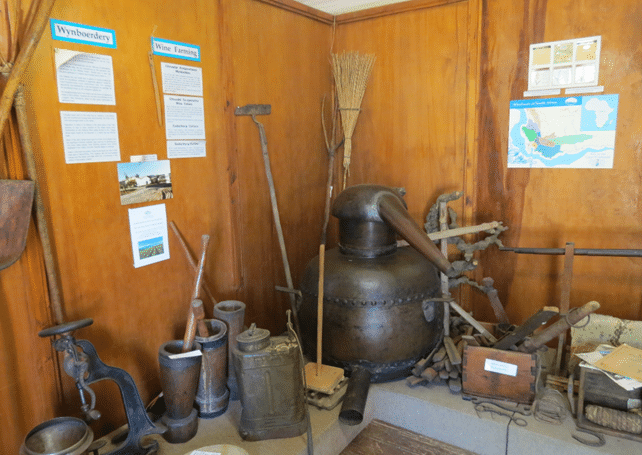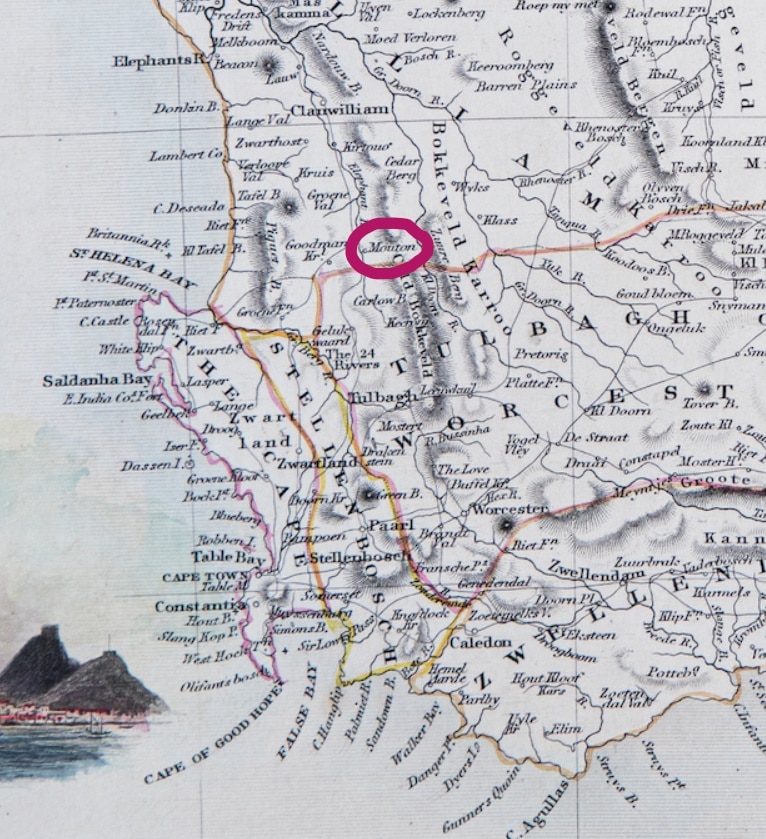SA wine history: Did Napoleon drink Citrusdal wine? (Part Two)
By Joanne Gibson, 2 October 2020

4
In my perhaps quixotic quest (read Part One here) to find out whether Napoleon drank wine from the Upper Olifants River area, I stumbled upon a blog post by journalist Clifford Roberts. He alerted me to an exhibition at the Citrusdal Museum, where a sign on the wall proudly states the following:
‘Long before the first commercial orange trees were planted, the fruits of the vine had brought fame to the valley. Napoleon, in exile on St Helena in the early years of the 19th century, is said to have insisted on the sweet wines from Brakfontein on the Olifants River being served to him. These wines were made by the Moutons in a cellar that can still be seen.’

I then came across a book called On Route in South Africa by BPJ Erasmus (Jonathan Ball, 1995) which makes this even more unequivocal statement: ‘Napoleon Bonaparte, while in exile on the island of St Helena (1815-21), insisted on dessert wines from this valley in addition to those from Constantia near Cape Town. The wines were supplied by the farm Brakfontein.’
Brakfontein (meaning ‘brackish spring’) is located about 10km north of Citrusdal and it no longer produces any wine. Today it is home to Mouton Citrus, one of South Africa’s leading growers and exporters of citrus fruit as well as rooibos, with Carmién Tea headquartered there.
I managed to get hold of owner Johan ‘Oubaas’ Mouton, who confirmed that he had heard the Napoleon story: ‘But unfortunately we have never found any substance to it. My ancestor, Christiaan Mouton from the adjacent farm Hexrivier, only bought Brakfontein in 1877, and Napoleon was on St Helena much earlier, from 1815 to 1821.’
Some further digging revealed that Brakfontein was in the hands of the Lubbe family during Napoleon’s St Helena years, as indeed it had been since 1752. When third-generation owner Paul Willem Lubbe died in 1810, his widow Jacoba inherited his estate, and included in the estate inventory was wine- and brandy-making equipment including two leaguers (577-litres each), seven and a half aums (about 144 litres each), and a ‘small boiler with accessories’. Given that Jacoba didn’t remarry but continued to live at Brakfontein until her death in 1835, was it possible that she (with her six children and two slaves) made wine that somehow made its way to St Helena?
It turns out not only that Jacoba was a Mouton – the daughter of Johannes Paulus Mouton, who had farmed at Modder Rivier at the foot of Piekenierskloof since 1765 – but also that by 1818 her daughter, Johanna, was married to another Mouton, namely Abraham Johannes Mouton (her mother’s first cousin). And here things get very interesting, because there is ample evidence that an Abraham Mouton was renowned for his nagmaal (communion) wine.
For starters, in The White Wines of South Africa (Balkema, 1967), WA de Klerk writes: ’There was the famous Nagmaal wine of Abraham Mouton of Brakfontein, near Clanwilliam, or the even more famous Nagmaal wine of Koos Hugo of Worcester.’
As I’ve revealed previously, Koos Hugo’s wine was regarded by some (including Germany’s ‘iron chancellor’ Otto von Bismarck and short-lived emperor Frederick III) as superior to the legendary sweet wines of Constantia. Now I can reveal that when C Louis Leipoldt wrote that he preferred Oom Koos Mosterdpotjie Wyn to the Kloster Eberbach Steinberger 1846 he had once tasted, in 300 years of Cape Wine (second edition, Tafelberg, 1974), his precise words were: ‘My recollection of that famous wine is that it was not to be compared with Oom Koos Hugo’s product, with which I was quite familiar, nor with that of Oom Abram Mouton’s, of the historic farm Brakfontein, who made a “Nagmaal” wine almost, but not quite, equal to the Worcester wine.’
While Abraham Johannes Mouton may have had a hand in making wine on Brakfontein, however, he never owned the farm, which his brother-in-law Barend Frederik Lubbe sold to Paulus Hendrik Stephanus van Zyl in 1839. It then remained in the Van Zyl family until 1877, when Mouton’s son, Christiaan Jacobus, purchased it for his son, another Abraham Johannes, who by all accounts moved there because he suffered from asthma, and Brakfontein was drier than Hexrivier, the Mouton family farm next door.
So which Abraham Mouton made the ‘famous’ nagmaal wine? Was it the older one, who was active during the Napoleon exile years but had no real claim on Brakfontein and died in 1851 at a farm named Patrysberg, some 6km north of Brakfontein? Or was it the younger one, who was 25 when he acquired Brakfontein in 1877 and 66 when he died there in 1918?
My guess is the latter, with his fame for nagmaal wine having somehow, over time, become linked to the more glamorous Napoleon story. A young man when he moved to Brakfontein, he was nonetheless old enough to be ‘Oom’ to C Louis Leipoldt, who was emphatic in his book that ‘excellent wines were made’ in the area before phylloxera destroyed the vines. ‘Few farmers have troubled to renew them on pest-proof stocks,’ he noted sadly.
Pre-phylloxera (and pre-Abraham jnr, for that matter), I have a feeling that the importance of the Mouton family network should not be underestimated – a feeling that only intensifies when I discover that Abraham jnr’s older sister, Maria Christina Helena Mouton, was married to Paulus Hendrik Stephanus van Zyl: yes, the owner of Brakfontein before her father purchased it.
And feelings aside, it’s an indisputable fact that the Mouton name stands out on John Tallis’s 1850 map of the Cape Colony, as a surname as opposed to a place name. There has to have been good reason for this.

It goes without saying that I have spent hours, days, trawling through records available online to find details about wine shipments to St Helena. In the papers of Sir Hudson Lowe, governor of St Helena, for example, there’s plenty about Constantia specifically, and plenty about Cape Wine generically (one bottle daily for each servant), but no mention that I’ve been able to find of Mouton or Brakfontein or Olifant/Oliphant/Elephant’s River or Clanwilliam (as the district was called from 1814 onwards, with concerted efforts made to settle hundreds of Irish immigrants there in 1820).
I discover that Captain William Underwood was appointed as the Cape Colony’s official wine taster in July 1816, tasked with ensuring only good wine was shipped overseas, but if he ever recorded anything noteworthy about wine from the Upper Olifants River, I have not yet been able to find it.
What I do know, from DJ van Zyl’s doctoral thesis entitled Die Geskiedenis van Wynbou en Wynhandel in die Kaapkolonie, 1795-1860 (University of Stellenbosch, 1973), is that the wine industry was booming during Napoleon’s exile years, with the average price per leaguer peaking in 1817 (at 183 Rixdollars) having more than doubled since 1812.
The question remains: what role did farmers from the Upper Olifants River play in all this? The answer is: more than you might think. If you, like me, are guilty of having always thought of the area as a fairly untamed frontier region, a bastion of wildness, fairly remote even now, let alone in the days before motorised vehicles and the N7, then prepare to be surprised.
Oh, and I’m following a new Napoleon lead…
- Joanne Gibson has been a journalist, specialising in wine, for over two decades. She holds a Level 4 Diploma from the Wine & Spirit Education Trust and has won both the Du Toitskloof and Franschhoek Literary Festival Wine Writer of the Year awards, not to mention being shortlisted four times in the Louis Roederer International Wine Writers’ Awards. As a sought-after freelance writer and copy editor, her passion is digging up nuggets of SA wine history.
Attention: Articles like this take time and effort to create. We need your support to make our work possible. To make a financial contribution, click here. Invoice available upon request – contact info@winemag.co.za
Comments
4 comment(s)
Please read our Comments Policy here.







Rioja | 2 October 2020
thank you
Stewart Prentice | 4 October 2020
Please keep going, this is wonderfully intriguing.
Tim James | 4 October 2020
We’re indebted, as always, to your digging, Joanne, and for entertaining stories such as this. But you have so far avoided confronting the main point I raised when I reluctantly dismissed the idea of Napoleon drinking a Piekenierskloof red. At that time: “it’s scarcely imaginable that commercial quantities of wine would have travelled by ox-wagon all the way to Cape Town (or, even more expensively, to Lamberts Bay and then by ship). This at a time when travel between Cape Town and vastly more important Paarl and Stellenbosch was on mere sand tracks that took days for those lumbering vehicles to cover.” Just think about that climb up to/down from Piekenierskloof. I rather doubt if an ox wagon plus load could have made it, even if there were more than the roughest of tracks on which to do so.
It’s pretty certain that there would have been some wine production there, as everywhere where there were settlers – for religious purposes, for domestic consumption (especially medicinal brandy), and probably to supply the dop system. But not for sending to the Cape Town wine market.
One does also wonder how it is that Napoleon could have come to hear about this wine (in order to insist on it) when there seem to be no contemporary records of its existence. Twentieth century assertions are no substitute, however vehement. But you say we must “prepare to be surprised” about the role played by farmers in the Upper Olifants area in the early 19th century, during the brief period when Cape wine was in great demand. I look forward to your future revelations.
Joanne Gibson | 5 October 2020
Tim, I assure you I’m getting there…